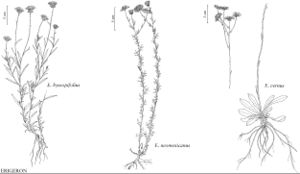Erigeron vernus
Fl. N. Amer. 2: 176. 1841.
Biennials or short-lived perennials, 15–50 cm; rhizomatous, fibrous-rooted, caudices relatively thick and short, or elongate rhizomes, or appearing simple, sometimes producing rosulate offsets. Stems erect, sparsely strigose to strigoso-hirsute or villous, eglandular. Leaves mostly basal (persistent); blades narrowly to broadly oblanceolate to spatulate, 20–100 (–150) × 4–25 mm (usually ± fleshy-thickened), margins entire or denticulate to mucronulate, faces glabrate eglandular; cauline mostly bractlike. Heads (1–) 4–20 (–25) in corymbiform arrays (from branches near apices). Involucres 3–4 × 5–11 mm. Phyllaries in 2–3 (–4) series, usually sparsely hirsute to strigose, sometimes glabrous, eglandular, sometimes viscid. Ray-florets 25–40; corollas white, 4–8 mm, laminae not coiling or reflexing. Disc corollas 2.5–3.8 mm. Cypselae subterete, 1.2–1.6 mm, 4-nerved, faces sparsely strigose; pappi: outer of setae, inner of 16–25 bristles. 2n = 18.
Phenology: Flowering (Mar–)Apr–Aug(–Oct).
Habitat: Moist to wet sites in sand or sandy clay or sandy peat, pine or pine-palmetto flatwoods and savannas, interdunal swales, road banks, ditches
Elevation: 0–50 m
Distribution

Ala., Fla., Ga., La., Miss., N.C., S.C., Va.
Discussion
Selected References
None.
